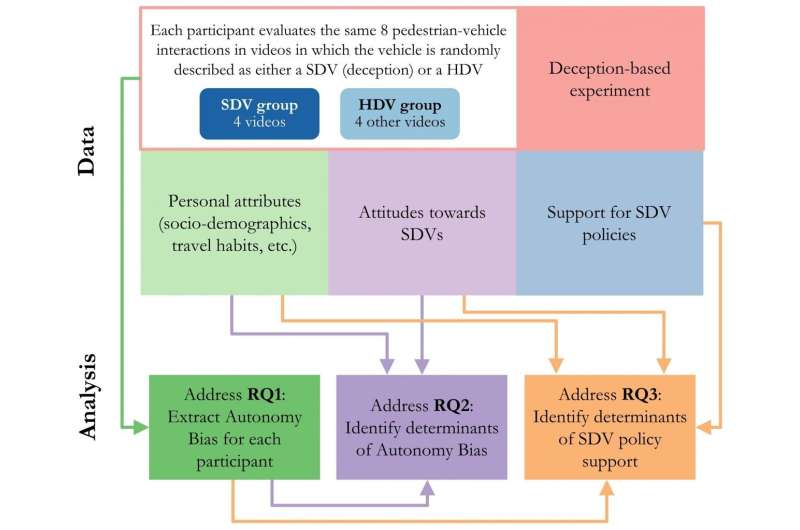Credit: University of British Columbia
While self-driving vehicles (SDVs) are being hailed as a solution for safer, more efficient roads, new research suggests British Columbians are not quite ready to embrace self-driving cars wholeheartedly—and will need a period of gradual transition before adoption.
The study, conducted by the Research on Active Transportation Lab (REACT) at the University of British Columbia, reveals mixed perceptions of automated vehicles, particularly their effects on pedestrian comfort and safety.
Do self-driving cars feel safe?
Four out of 10 participants (41 percent) thought that pedestrians faced reduced safety and comfort levels in SDV interactions compared to conventional human-driven vehicles. In contrast, 34 percent viewed SDV interactions more favorably, while 25 percent reported no bias in either direction.
The study engaged 1,133 participants from across B.C. and aimed to assess public sentiment toward self-driving vehicles. Participants watched eight video clips showing interactions between pedestrians and vehicles at crosswalks. Half of the vehicles were labeled as self-driving, while the other half were marked as human-driven. In fact, all the vehicles in the videos were operated by humans, a test design that allowed the researchers to detect biases in perceptions.
Skeptics, optimists and neutrals
"People who harbor anxiety or discomfort regarding new technology were more likely to hold a negative bias against SDVs. Similarly, residents in the Lower Mainland tended to adopt a more critical viewpoint, likely because there are more pedestrians in this urban region," noted Gurdiljot Gill, a civil engineering Ph.D. candidate who conducted the study.
Opinions also diverged on the broader question of permitting SDVs on public roads. Among those surveyed, 55 percent voiced support for allowing shared SDVs, such as taxis or shuttles, while 48 percent backed privately owned SDVs.
However, there was marked consensus around regulation: up to 92 percent of participants approved of rules such as ensuring driverless cars have identifying marks and requiring a human driver in the driver's seat, prepared to take control in an emergency.
Self-driving car regulation
Given these complex public sentiments, the researchers propose a gradual introduction of SDVs on city streets—starting with a controlled pilot testing phase—to address safety concerns and avoid negative impacts for pedestrians and other travelers.
They also advise running robust public education campaigns to build familiarity and emphasize the potential benefits of self-driving cars, and beginning pilot testing with shared rather than private SDVs.
Other recommendations include requiring that SDVs:
- adopt more conservative road behavior than human-driven cars, particularly in urban settings—such as allowing an additional two to four seconds for pedestrians at crosswalks;
- use external communication features to signal their automation to other road users;
- have a human in the driver's seat, to take control in an emergency;
- avoid designated pedestrian priority zones, like those around schools
The researchers say the study is the first to measure perception biases in the population toward SDVs.
"At this critical point in the introduction of automated vehicles, it is essential to understand and consider their effects on everyone who shares city streets—especially pedestrians," said Dr. Alex Bigazzi, associate professor of civil engineering at UBC and REACT principal investigator.
With ride hailing and SDV testing in other places, industry often determined policy by launching without sufficient system-level planning or controls, he noted.
"A lack of proactive policy in some regions resulted in problems and missed opportunities for integrating new technology in ways that advance system goals such as sustainability, equity and accessibility. We hope this research enables policy-makers to ensure that the introduction of automated vehicles is strategic and directed toward the public good."
More information: Report: reactlab.civil.ubc.ca/perceive … lf-driving-vehicles/
Provided by University of British Columbia






















